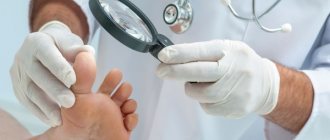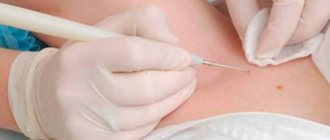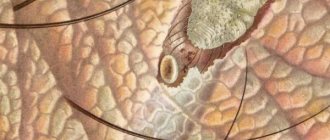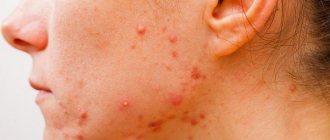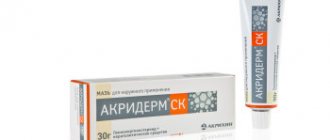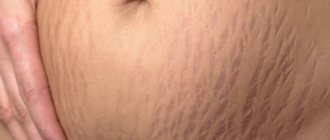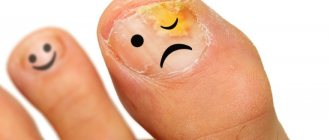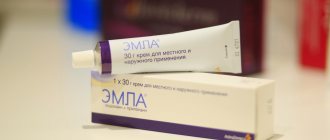Nail fungus (onychomycosis) most often parasitizes the big toes. This is facilitated by a favorable environment, a large area for the life and reproduction of pathogenic microorganisms. Incorrect self-medication or late seeking medical help leads to a radical measure - removal of the diseased plate. Usually it is treated in a doctor's office, but there are medications that can help remove nails affected by fungus at home.
Nails with onychomycosis
Why do you need to remove the nail plate?
Onychomycosis is infection of the nails by parasitic fungi. Pathogenic flora destroys the horny plate, as indicated by:
- cloudiness;
- White spots;
- swelling of the periungual fold;
- redness of the nail bed;
- thickening;
- breaking off the free edge;
- deformation.
Untimely destruction of the fungus is fraught with a change in the shape of the plate, deepening the free edge into the skin. In 8 out of 10 cases, patients seek help for advanced onychomycosis and bacterial complications.
Removing a fungal toenail is an effective way to get rid of the infection. After removing the plates, the doctor prescribes antifungal ointments and solutions for treating the subungual space. Radical treatment of onychomycosis is indicated for:
- inflammation of the periungual and subungual spaces;
- fungal infection of more than 70% of the stratum corneum of the finger;
- severe deformation of the plates;
- frequent relapses of onychomycosis;
- infection of the growth zone.
Complete removal of the nail plate is dangerous due to complications - bacterial infection, suppuration. In 2/3 of cases, they are limited to removing only the top layer or part of the nail.
Hardware and surgical removal methods
To remove a nail affected by a fungus, especially in advanced cases, surgery, the use of a laser or a special pedicure device can be performed.
Operation
The intervention is carried out either in an outpatient clinic or in a hospital. Local anesthesia is used first. The algorithm is as follows:
- using a scalpel, separate the nail from the bed;
- the plate is completely removed;
- the wound is treated with antibiotics and other agents to prevent infection.
After this, the patient is sent home.
Important!
Surgical nail removal may be contraindicated. We are talking about a violation of the permeability of blood vessels in the lower extremities, as well as a low rate of healing of the integument.
Hardware pedicure
A hardware pedicure allows you to remove a toenail. For this purpose, a milling cutter with rotating elements and replaceable abrasive attachments is used. Hardware pedicure is also performed by a doctor, not a pedicurist.
The advantage of the method is that it saves time, because the plate is cut down literally in one go. Compared to, for example, a surgical procedure, this is a more gentle method of removing a nail. Bleeding is eliminated, and since there are no open wounds, recovery is much faster. There are no pains or other unpleasant sensations.
Laser nail removal technique
Laser removal
Another safe way. It allows you to quickly remove a nail affected by fungus. The laser is set to the desired temperature, then the problematic surface is completely or partially removed. The advantage of the technique is the complete removal of the fungus and its spores on the nail plate.
Advantages of the laser procedure:
- excellent result because the mycosis pathogen is 100% destroyed;
- maximum gentle impact on the problem;
- intact (normal, healthy) skin is not affected.
At the same time, the likelihood of mycosis recurrence is negligible.
Preparing for removal
There are several ways to remove horny plates affected by the fungus. To make the procedure less painful, they undergo a preliminary preparation stage:
- Steaming. The first step is to steam your foot in a hot bath. To do this, use a chamomile decoction or a solution of laundry soap and baking soda. The procedure is performed for at least 25-30 minutes.
- Removing the top layer. The softened parts are cleaned off with nail scissors, a nail file or a scraper for better penetration of pharmaceutical products into the lesions.
- Skin protection. Most drugs for removing horny plates contain aggressive additives. Therefore, before applying them, the periungual fold is covered with an adhesive plaster.
After preparation, softening agents are applied to nails with fungus.
Pharmaceutical nail removers
Doctors warn: removing the nail plate completely, right down to the bed, is very dangerous. Even a diseased nail performs its natural protective function, and if you remove it completely, you can provoke an even more serious infection.
Therefore, pharmaceutical products for removing diseased nails at home - keratolytics - are very popular. They allow you to remove diseased tissue gradually and very carefully. Doctors often advise not to remove the nail completely: a healthy one will still grow back, and the remnants of the affected tissue will fall off on their own as the new nail grows.
The most popular means for treating fungal infections are ointments and creams, antifungal varnishes and plasters (special solid ointments).
How to remove a nail affected by fungus using pharmaceutical products
Therapy of onychomycosis is carried out with special drugs, most of which have a complex effect:
- antifungal;
- antiseptic;
- keratolytic;
- softening.
Removal of nails affected by fungus is carried out with softening varnishes, ointments or plasters. In 80% of cases, damaged parts can be removed in 2-3 procedures.
Before applying the drug, all areas affected by the fungus are treated with antiseptics - Chlorhexidine, Miramistin, Furacilin solution.
Plasters
A patch is a nail remover that softens the stratum corneum on the fingers. Facilitates the removal of layers infected with fungus. Most patches contain:
- keratolytics – trichloroacetic and salicylic acids, urea;
- antiseptics – miramistin, ammonia, chlorhexidine;
- antimycotics – bifonazole, miconazole, ketoconazole.
When treating fungus, the following keratolytic plasters are used:
- Mycospor is a patch with a pronounced antifungal and keratolytic effect;
- Onychoplast is a patch with urea, paraffin and beeswax, which additionally disinfects the skin in affected areas;
- Ureaplast is a urea-based product that softens nails and destroys fungal spores;
- Fungiplast is a drug with a fungicidal and softening effect that makes it easier to remove part of the infected nail.
To remove all layers of fungus, it is recommended to apply for at least 5 days.
Lucky
Products in the form of varnishes act similarly to keratolytic patches. They are applied in several layers after steaming the hands or feet. Most varnishes contain fungicidal components. Therefore, they treat not only the areas infected with the fungus, but the entire surface of the horny plate. Periodically, the softened layers are cleaned off with nail scissors, a file, or a milling cutter.
To remove the nail plate with nail fungus, the following are prescribed:
- Batrafen;
- Mikozan;
- Loceril.
Keratolytic varnishes should not be confused with varnishes designed to kill fungus.
The former soften the horny covering of the fingers, and the latter destroy the fungal infection. Compared to other forms of keratolytic agents, varnishes are easier to apply. Before the procedure, the periungual fold is not covered with adhesive tape or treated with fatty creams. The risk of getting a chemical burn when using varnish is minimal.
Ointments
With advanced onychomycosis, the deep layers of the nail are affected. To defeat the infection, all layers of the plate are removed down to the affected area. Ointments and creams have better penetrating ability.
To remove nails use:
- Loceryl is a cream with amorolfine and urea, which is intended for the gentle removal of nails with fungus;
- Nogtivit is a product with urea and essential oils that has disinfecting and keratolytic properties;
- Nogtimycin - cream for removing nails for fungus with keratolytic and fungicidal activity;
- Mycospor is an ointment with bifonazole and urea, which is intended for non-surgical nail removal.
When treating affected areas with keratolytic ointments, the following recommendations should be followed:
- the product is applied to the lesions in a thin layer once a day;
- the treated areas are sealed with adhesive tape;
- the dressing is changed every 24 hours;
- between changing bandages, steam your legs or arms;
- the exfoliating parts of the horny cover are removed with a scraper;
- After the procedure, the nails are covered with a layer of ointment.
Therapy is carried out for at least 2 weeks in a row. When the subungual space acquires a smooth structure, this indicates the destruction of the fungus.
Removal methods
There are several ways to completely trim the required nail.
Medicines
Pharmaceutical companies have developed many products that help quickly and painlessly remove the nail plate on the thumb or any other finger. The most popular among them:
- Creams and ointments (Nogticin, Mycospor, Lotseril). For them to work, you must soften the problem nail before applying it. A soap and soda bath is suitable for this. The top loose layer is carefully removed using a nail file, and the skin around the plate is covered with adhesive tape. Only after the medicinal composition is applied to the problem surface, the finger is wrapped with an adhesive plaster. The drug is left for the time specified in its instructions (from several hours to days). After removing the patch, the feet are steamed again. Using a file, remove the softened top layer and, if necessary, repeat all procedures.
- Keratolytic plasters (Fungiplast, Ureaplast, Onychoplast). First you need to thoroughly soften and clean the nail plate in the manner described above. The patch is glued to the problem area and kept for 1-2 days. After removing the patch, all steps are repeated again.
- Medicinal varnishes (Mikozan, Lotseril, Batrafen). Before using them, you should trim your nails as much as possible and remove the top keratinized layer using a nail file (most often sold with the drug). The varnish is applied in several layers daily. Duration of use is about two months.
Mechanical method
This method of removing nail plates with fungus is practiced by many cosmetologists and dermatologists. Using it yourself is quite difficult and unsafe.
Removal of problematic tissues is carried out according to the following scheme:
Causes of uneven nails and effective treatments
- Nails and the skin around them are treated with antiseptics.
- Tissues affected by the fungus are removed using a special tool with an abrasive attachment. Removal of the nail plate is carried out sequentially until the subungual bed is completely free.
- The finger is re-treated with an antiseptic.
The procedure can last from 30 minutes to several hours, depending on the area being treated.
Removing nails at home: folk recipes
To remove toenails, products with keratolytic, alkalizing and antimycotic properties are used. They create conditions unfavorable for fungal growth.
With vinegar
Vinegar softens the stratum corneum and prevents fungal infections in the subungual space. To completely cure onychomycosis, treatment is carried out for at least a week. Removing a nail with fungus is done with the following means:
- 1 chicken egg mixed with 3 tbsp. l. vinegar;
- add 3 drops of thyme essential oil;
- leave in a dark place until the yolk is completely dissolved.
The product is applied to infected nails twice a day. The softened layers are cleaned off with a scraper.
With dimethyl phthalate
Dimethyl phthalate has fungicidal and softening properties. To remove the affected nail, you need:
- mix 1 tbsp. l. dimethyl phthalate with chicken egg;
- add 5 ml of vegetable oil;
- apply the prepared mixture to the areas affected by the fungus;
- Wrap your feet in plastic and put on warm socks.
The treatment is carried out 4-5 days before bedtime. The softened layers of the nail are cleaned with a scraper immediately after waking up.
With tar
Tar prevents the proliferation of most pathogens of onychomycosis - yeast and mold fungi, dermatophytes. Toenail removal on the big toe is carried out as follows:
- 30 minutes before bedtime, apply tar to the affected area;
- the foot is wrapped in plastic film;
- warm your feet with woolen socks;
- after waking up, the remaining tar is washed off with water;
- The softened layers are removed with scissors.
The procedure is performed until the layer with white spots is completely cleaned off.
To avoid re-propagation of fungi, antimycotic ointments are applied to the affected area for 3-7 days.
With soda
Soda baths are a painless and effective way to combat fungus. With severe symptoms of onychomycosis, the legs float daily for at least 1.5-2 weeks. To cure a nail with fungus, you should:
- dissolve 2.5 tbsp in 2 liters of boiled water. l soda;
- add 3 tbsp. l. tar soap shavings;
- immerse your feet in the solution for a quarter of an hour;
- remove the peeling parts of the plates with a scraper.
If the nail bed becomes red, you need to add sage oil to the solution or treat your nails with it after steaming.
How to remove a nail at home
Fighting foot fungus can also be done at home. For this purpose, various medications are used. Additionally, folk remedies are used. However, they should be just a side part of therapy. The main emphasis should still be on medications.
Nail removal patches
The first step towards recovery can be the use of patches. They are effective at the initial stage of mycosis and when the damage has not reached a large scale.
Keratolytic patches are especially effective. They are more convenient to use than ointments. Provide safe removal of the thumbnail with fungus. In addition, patches are characterized by a lower likelihood of the active ingredient getting on healthy skin. Most often, experts prescribe the following types:
- Onychoplast. The main component is urea. It speeds up the nail removal process. It is used as follows: a small amount of the plaster mass is rubbed between your fingers. Then applied to a previously cleaned surface. A bandage is applied on top and left for several days. Be sure to remove dead skin folds.
- Ureaplast. The active ingredient in this patch is also urea. However, it belongs to the lead variety. The top layer is removed from the steamed and cleaned nail plate. Then apply the product and cover with a bandage. Leave it for a day, then repeat the procedure. This must be done until completely softened.
Overall, the patches are effective. However, they do not help in advanced cases or with extensive spread of mycosis.
Using medication to remove the nail
Application of ointments
The most common remedies are Nogtivit and Nogtimycin. The first is a thick emulsion containing lactic acid and urea. They help soften the plate.
Note!
Before using Nogtivit, the problem area is soaked in a hot bath with Furacilin solution, then dried.
Next, the ointment for removing the nail is applied in a thick layer. It is covered with a plaster and left for 24 hours. An undeniable advantage is its gentle effect on the nail. Experts consider the disadvantages to be long-term achievement of the desired effect and the likelihood of an allergic reaction to the components.
Nogtimycin helps remove fungal toenails at home. The list of its components that soften the nail includes carbamide (urea) and salicylic acid. The algorithm is as follows:
- ointment is applied to the previously prepared nail plate, with a patch on top;
- after three to four days, remove the bandage and take a hot bath - this will soften the plate;
- keratinized areas are removed.
The disadvantage of treatment is the need to constantly change dressings.
Using ointments to remove a diseased nail
Special sets
A universal remedy in the fight against mycosis is Mycostop. This is a very convenient set with accessories necessary for quickly treating fungus.
From the point of view of the dosage form, it is an ointment for external use. It has a uniform consistency and has a whitish-yellow tint. The set includes a package with a waterproof patch, a scraper and an ointment dispenser.
Mycostop is applied to the affected nail surface once a day. The composition should cover its entire surface with a thin layer. Each plate is sealed with adhesive tape. A day later it is removed. Keep the nail in warm water for 10 minutes. After this, the part of the infected plate that has managed to soften is removed from the set using a scraper. After completing the procedure, the nails are thoroughly dried. Then the ointment is reapplied and sealed with a band-aid.
On a note!
The duration of treatment depends on the thickness of the nail plate and the degree of fungal infection. Typically, recovery takes from seven to 14 days.
How to care for your nail after removal
Removing deformed horny plates often leads to skin injury. Proper care prevents finger wounds from becoming infected. To completely destroy the infection, the subungual space is treated with antimycotic ointments. They are applied under a bandage, which is changed at least 1-2 times a day.
Basic rules of care:
- dressing is performed until all wounds have healed;
- avoid getting water on areas infected with fungus;
- wear socks only made of cotton fabric;
- shoes are disinfected daily with antiseptic and antifungal sprays.
After removing toenails, it is recommended to remain in bed for the first 2 days.
Complete nail renewal occurs in 6-8 months. If, after treating the fungus, the subungual space swells or festers, you should consult a dermatologist. This reaction indicates the addition of a secondary infection. To destroy it, antibiotics are used in the form of ointments or tablets.
The use of folk remedies
All traditional methods of removing nails are based on softening them and then removing them. Manicure devices are used for this. Let's look at how to remove a nail affected by fungus at home.
- A soda-soap bath helps to steam your nails, after which they can be removed with a nail file. You need to add a little baking soda and laundry soap to the water. The duration of the procedure is at least 20 minutes.
- Using water and the drug Metronidazole, a paste is obtained, which is applied to the affected area at night. You can remove it with a manicure file.
- You can remove the fungus using an egg dissolved in vinegar. The course of therapy is a week, and the product must be applied twice a day.
- Diseased nails are steamed, after which they are covered with concentrated acetic acid. Such procedures are carried out 2 times a day. 10 days of treatment is enough to completely remove the affected tissue.
- An ointment is prepared from vegetable oil, dimethyl phthalate and chicken eggs. It is applied to the affected area. The procedure should be repeated 6 times before bedtime.
Important!
Traditional methods of nail removal must be used for a long time - sometimes up to a month. Only regular use of medicinal products will help achieve a positive effect.
What not to do
Inadequate treatment of onychomycosis is one of the key reasons for the spread of the fungus and purulent complications. When removing nails you should not:
- interrupt therapy at the first signs of improvement;
- try to remove the entire nail along with the growth zone;
- completely replace pharmaceutical drugs with folk remedies;
- steam your feet in hot water with obvious signs of purulent inflammation of the skin;
- treat the affected areas with warming ointments;
- independently trim the deformed edges of the plates immersed in the skin.
With the hyperkeratotic form of onychomycosis, the horny covering on the fingers is severely deformed, which leads to painful sensations. To alleviate the condition, many patients trim the corners of the free edge of the nail. But such actions in 75% of cases lead to onychocryptosis - ingrowth of the lateral edge of the plate into the nail fold.
Complications
Any removal of the nail plate can lead to the development of a number of extremely unpleasant complications, including:
- Development of chronic pain syndrome. This complication usually occurs due to the patient’s rapid return to normal life. Regular shoes are not designed to be worn without a nail, so ordinary activities will cause pain and discomfort.
- The appearance of a chronic wound. Such a complication can occur even with minimally invasive intervention if the patient has a certain predisposition. The risk of its development increases with impaired blood supply to the extremities, neuropathy of various etiologies, constant trauma, etc. Chronic wounds appear especially often in patients with diabetes mellitus.
- Deformation of the nail plate. If a growing nail is subjected to pressure and damage, it can grow crooked and cause severe physical and aesthetic discomfort. Deformation can also be the result of an incorrectly performed intervention (for example, damage to the nail matrix).
- Complications of the operation itself. Among them are allergic reactions, suppuration of the intervention site, etc.
It is worth emphasizing once again that not a single option for removing a nail for a fungal infection can by itself provide a cure for the patient. Therapy should be comprehensive and carried out under the close supervision of a qualified dermatologist.
How to remove diseased nails in a clinic
If the fungus affects the stratum corneum on 2-3 or more fingers, treatment is carried out in the hospital. Treatment methods for onychomycosis depend on the condition of the nails and the skin underneath them:
- Hardware removal. Medical pedicure is a painless method of removing horny plates infected with fungus. The procedure involves layer-by-layer thinning of the nail using special attachments. Used for superficial onychomycosis.
- Laser therapy. Using a laser, the fungus is destroyed in the affected area. Before the procedure, the sore spot is treated with an antiseptic, after which it is exposed to laser beams. When treating onychomycosis, 3 to 7 laser therapy sessions are performed.
- Surgical removal. Nail removal surgery is performed under local anesthesia. The finger is tied with a tourniquet and part or the whole nail is cut out. To completely remove the fungus, antifungal ointments are rubbed into the nail bed.
Surgical removal is not often used due to the fact that new nails grow unevenly.
Such an operation is resorted to only in advanced forms of onychomycosis. To prevent the fungus from reproducing, it is recommended to wear shoes made of breathable materials, treat hyperhidrosis and treat the interdigital area with antifungal powders. If preventive measures are taken, the likelihood of relapse is reduced by 60%.
Why doesn't it grow after removal?
Sometimes, after removing a nail due to fungus, a new nail is in no hurry to grow back. A similar situation may arise when:
- Significant decrease in immune activity.
- Residual development of fungus (incompletely treated infection).
- Complications after surgery. This is perhaps the most difficult situation, because if the growth zone of the nail was damaged during removal, a new plate may not grow. Choosing a really good clinic helps reduce the risk of such a complication.
If the new nail plate does not begin to grow a couple of months after removal, you should definitely consult a doctor. The doctor will determine what is causing the problem and determine whether the nail has a chance of growing back.
